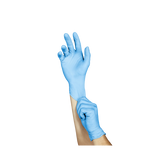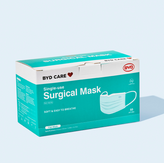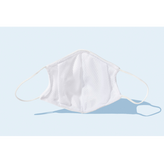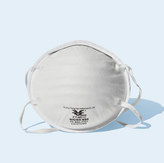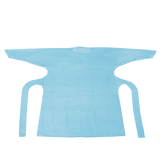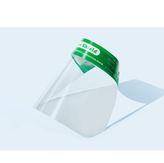Necessity is the mother of invention, and N95s are no exception. The use case for N95s has changed – now a healthcare worker is expected to wear it all day instead of a couple hours at a time. That means the product needs to change.
Since the pandemic began we’ve heard a variety of feedback from NIOSH N95 wearers, including comments such as “I’m tired at the end of the day when I wear this” and “this hurts my nose.” One of the most common complaints we hear is about sizing — mostly masks being too big. One dental practice told us “our hygienists can’t pass the fit tests with these cup-shaped masks.”
At the same time we’ve also kept an eye on innovation in the market, and we’re happy to report that change is afoot.
What is changing about mask usage?
Longer wear - Prior to the pandemic, medical practitioners typically used N95s for a handful of hours — a much shorter time frame than today. Now, nurses and doctors are wearing masks throughout an entire eight to ten hour (or longer) shift and even posting pictures of their facial bruises on social media to share their mask battle scars. While masks are good at blocking particles, a well-fitting mask will also reduce oxygen intake which results in workers feeling tired by the end of their workday and also decreases effectiveness as it encourages workers to remove or fiddle with masks to breathe better.
More users, particularly women - A greater variety of practitioners are wearing N95s now than before. Pre-pandemic, dentists did not regularly need N95s, nor did their hygienists, and neither did hospice or nursing home workers. Nursing, end-of-life care, and dental hygiene are female-dominated industries. As such, the need has grown for masks that fit a wider variety of face shapes and sizes, particularly a more petite facial structure.
Reuse - N95s are manufactured to be a one-time use, disposable product. That said, in light of budget and purchasing constraints, medical practitioners are now being asked to ration and reuse N95s. The CDC has put out guidance for recommended reuse of masks in light of how widespread this practice has become. That said, for the most part, N95 masks are continuing to be manufactured as disposable, one-time use products - with equivalent regard for comfort - as opposed to multi-use, long-wear items.
More options - Before March of 2020, the US medical community largely used N95s from two major manufacturers in the US, 3M and Honeywell - the 3M 1860 and 3M 8210 were the gold standards in US medicine. Industrial and construction users who needed a less expensive product (and notably for whom N95s were originally developed) had ventured into China-manufactured NIOSH N95s, often via a rebranded product made for the US market. A COVID-19 silver lining is the new NIOSH-rated masks that entered the medical market, largely from outside the US. Alternative suppliers stepped up when 3M and Honeywell became oversubscribed. More product competition means more opportunities for nurses and doctors to find a comfortable mask with a better fit.
What innovation is happening?
Thankfully, a fair amount of innovation has been cropping up to help mask-wearers, ranging from ear savers for earloops, to reusable N95s made of silicone, to a mechanism that improves mask oxygen flow. For our purposes, we will focus on good ideas we have seen that build upon the most-widely consumed medical grade N95 product which is the standard, disposable NIOSH N95 mask. It must be said that much of the innovation we have seen has come from taking a closer look at the newer line of masks being produced by Makrite. See our interview with Bob Wen, the CEO of Makrite where we discuss his company’s innovation focus.
Innovations:
Adjustable headbands - A major improvement to the standard double elastic, braided and stapled headband that we see on the 3M 1860 or most other N95s is a pair of adjustable headbands that are thicker and have a rubber slider that allows for a perfectly tightened fit. Particularly in a world when there are more faces shapes and sizes, as well as continual re-wear that may weaken elastic, being able to cinch the N95 tighter is a great add.

Better breathability - Manufacturers are now focusing on the meltblown and crafting processes in order to make masks more breathable and therefore ensure good wear. A differential pressure test is applied to masks to measure the resistance of the mask to air flowing through it. Lower numbers mean more a breathable mask. In conversations with Makrite, we understand that whereas the 3M 1860 has a breathability index of 11, improvements to meltblown technology are resulting in the newer models having a better breathability rating at 5/6 for the Makrite 801 and Makrite 9601.

Bigger foam nose strips - Standard foam strips are applied under the malleable metal nose clip for all NIOSH N95s, but we were pleasantly surprised by the substantially thicker foam strip on the Makrite 801. Gaps between the wearer's face and the mask can often happen around the nose bridge when there is imperfect fit. A thicker foam strip here helps fill in that space to provide a better fit.

Different N95s shapes for different faces - Whereas the western market predominantly prefers a cup-shaped mask, now there are many more on the market - vertically folded, duck bill, trifolds, etc. These masks can often be the answer for smaller faces or for folks who are seeking more cloth-like comfort than a hard molded-cup shaped mask may provide. 3M has the 1860S (small size), as do many others. However, we have seen that the Honeywell 901 (a folded mask, but NOT an N95) fits the most petite faces when other small-sized N95s fail. Additionally, the 3M 9502+, which is a product made by 3M’s China division, is an N95 that fits the widest variety of face shapes and sizes.
Crushable masks - A dented cup-shaped mask isn’t too helpful. However, the new Makrite 9601 is a “crushable” cup-shaped mask where the material defaults to a cup-shaped form but can easily be crushed and pop back into shape with no issue.
More defined nose indentations - A fitted mold around the nose bridge is the standard for 3M 1860 and most Moldex masks, yet a deeper, more defined nose indentation is a fit improvement we have seen over the almost completely rounded cup-shaped masks, such as this one by Guangzhou Harley.
Removable silicone seal - One of the more novel things we came across is Makrite’s 9800-N95 model which features a removable silicone seal around the cup. It’s also possible to purchase these in different colors. In one fell swoop, Makrite addresses mask cleaning, reusability, comfort and fit around the edge of the mask, as well as personalization.
Innovation in N95s is sorely needed. We appreciate that manufacturers have been looking for ways to make N95 masks more comfortable, breathable, and safe for extended amounts of time. We are hopeful that all manufacturers can implement some of these ideas to introduce new masks that speak to the market feedback in recent months.


